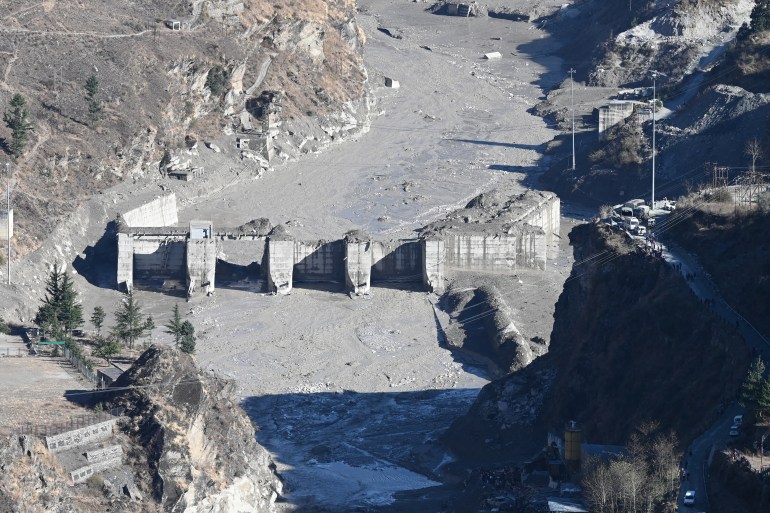Many die, hundreds missing as Himalayan glacier bursts in India
Uttarakhand government officials say 26 bodies recovered while at least 171 people are still unaccounted for.

Indian rescuers are searching for more than 170 people missing in the Himalayas, including some trapped in a tunnel, after part of a glacier broke away, sending a torrent of water, rock and dust down a mountain valley.
Sunday’s violent surge below Nanda Devi, India’s second-highest peak, swept away the small Rishiganga hydroelectric project and damaged a bigger one further down the Dhauliganga river being built by state firm NTPC.
Keep reading
list of 4 itemsIn Pictures: The deadly glacier collapse in Indian Himalayas
Why glaciers burst and send floods downstream
Melting glaciers, rising seas: Approaching climate tipping points
More than 2,000 members of the military, paramilitary groups and police have been taking part in search-and-rescue operations. Uttarakhand Director General of Police Ashok Kumar said late on Monday that 26 bodies had been recovered.
Final number of dead body recovered in Tapovan till 8 p.m. on 8th February is 26. 171 people still remain missing out of which around 35 are supposed to be in the Tunnel where rescue operation is still going on.@DDNewslive @ANI @aajtak @ZeeNews @ABPNews @htTweets @timesofindia
— Ashok Kumar IPS (@Ashokkumarips) February 8, 2021
Most of the missing were people working on the two projects, part of many the government has been building deep in the mountains of Uttarakhand state as part of a development push.
Videos on social media showed water surging through a small dam site, washing away construction equipment and bringing down small bridges.
“Everything was swept away, people, cattle and trees,” Sangram Singh Rawat, a former village council member of Raini, the site closest to the Rishiganga project, told local media.

Rescue squads were focused on drilling their way through a 2.5km (1.5 miles) tunnel at the Tapovan Vishnugad hydropower project site that NTPC was building 5km (3 miles) downstream and where about 35 workers were believed trapped.
“We are trying to break open the tunnel, it’s a long one, about 2.5km,” said Ashok Kumar, the state police chief. He said rescuers had gone 150 metres (490 yards) into the tunnel but debris and slush were slowing progress.
There had been no voice contact yet with anyone in the tunnel, another official said. Heavy equipment has been employed and a canine squad flown to the site to locate survivors. On Sunday, 12 people were rescued from another, much smaller, tunnel.
Meanwhile, Al Jazeera’s Elizabeth Puranam in India reported that some rescue teams were out on the river hoping to find survivors.
“Our team is hear searching. If we see anyone near the banks or in the river, our work is to recover them,” Manjari Negi of the State Disaster Response Force told Al Jazeera.

It was not immediately clear what caused the glacier burst on a bright Sunday morning. Experts said it had snowed heavily last week in the Nanda Devi area and it was possible that some of the snow started melting and may have led to an avalanche.
Uttarakhand is prone to flash floods and landslides and the disaster prompted calls by environmental groups for a review of power projects in the ecologically sensitive mountains. In June 2013, record monsoon rains there had caused devastating floods that killed close to 6,000 people.
A team of scientists was flown over the site of the latest accident on Monday to find out what exactly happened.
“It’s a very rare incident for a glacial burst to happen. Satellite and Google Earth images do not show a glacial lake near the region, but there’s a possibility that there may be a water pocket in the region,” said Mohd Farooq Azam, assistant professor of glaciology and hydrology at the Indian Institute of Technology in Indore.
Water pockets are lakes inside the glaciers, which can erupt, leading to an event like this. Environmental groups have blamed construction activity in the mountains.
Himanshu Thakkar, coordinator of the South Asia Network of Dams, Rivers and People, said there had been violations of clear government recommendations against the use of explosives for construction purposes.
The latest accident had also raised questions about the safety of the dams.
“The dams are supposed to withstand much greater force. This was not a monsoon flood, it was much smaller,” said Thakkar.